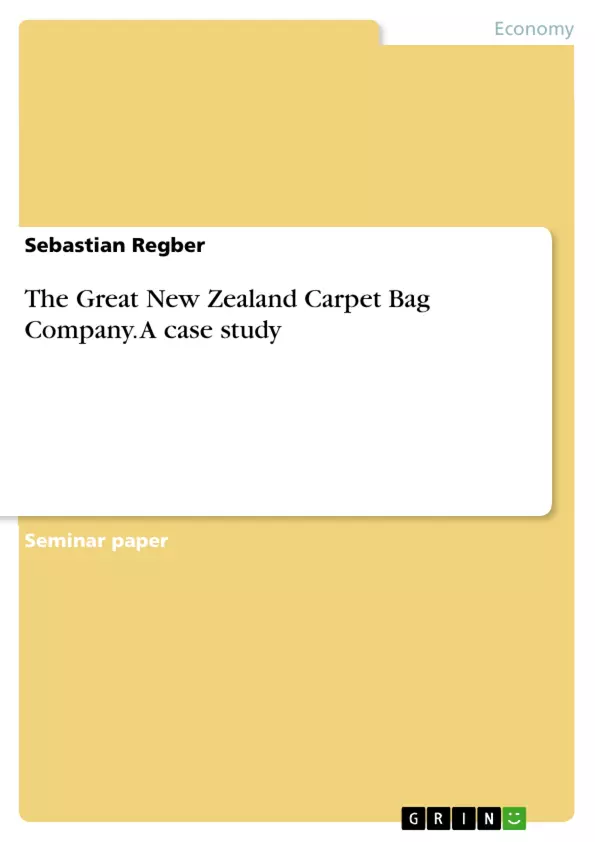This paper presents a business plan to enable the fictional Great New Zealand Carpet Bag Company to prevent bankruptcy and to achieve sustained performance. Furthermore, the paper analyses the current situation of the GNZCBC and makes recommendations to overcome past failures of the company.
Operations management objectives and current weaknesses are analyzed in Chapter 2. It is found that the foremost and immediate issue is the financial crisis, i.e. the bank is pressing for the repayment of a loan of $ 2,000,000. Further, the organisation is challenged with various difficulties such as low efficiency caused by a tremendous overcapacity in stock and an unplanned operating system structure. Hence, the performance and profitability of the company is poor.
Thus, the author will come up with a business plan to overcome the situation and turn the business around with a business policy change in chapter three. Actions consist of changing the operating system structure, closing retail shops, moving the head-office and drastically reduction in staff, input and output stock. Further, it is suggested to quit leasing contracts for storage space since they are simply not needed.
The last chapter provides the implementation of the policy change and offers recommendations for ongoing performance. Particularly, cost cuts and communication are major topics to deal with as well as the operation system structure and the total supply chain approach.
The conclusion gives an overall review and summary of the actions taken to make the company achieving lender compliance and continuing business successfully. Substantial improvement in efficient resource utilisation to draw profit and become sustainably profitable is one of the key steps. Further actions include the implementation of both Just-in-time and Enterprise resource planning systems as well as applying forecasting models while focussing on core competency. Hence, the company has got a new base of operations to start with and a basis to negotiate with the bank in order to prevent seizing.
Inhaltsverzeichnis (Table of Contents)
- Executive Summary
- Introduction
- Definitions
- The Case
- Analysis
- Operations objectives
- Definitions
- Customer Satisfaction
- Resource Utilization
- Relationship Customer Satisfaction and Resource Utilisation
- Product Life Cycle (PLC)
- Financial Obligations as foremost problem
- Operating System Structures
- Basics
- Limitations
- Capacity Management
- Definitions
- The Factory with its Production Unit
- Measuring Capacity
- Determination of Demand
- Capacity Management Strategies
- Production Scheduling
- Quality Performance
- Definition
- Applicable Quality Standards
- Performance Measurement
- Summary Analysis
- Operations objectives
- Policy Change
- Implementation and ongoing Performance
- Customer Service
- Resource Utilisation
- Capacity
- Marketing
- Inventory and Supply Chain
- Internal Communication and Management Style
- Quality and Control of Resources
- Scheduling
- Sustainable Performance
- Conclusion
- References
- Reflective Statement
Zielsetzung und Themenschwerpunkte (Objectives and Key Themes)
This case study focuses on the financial crisis faced by The Great New Zealand Carpet Bag Company (GNZCBC) and presents a business plan to prevent bankruptcy and achieve sustained performance. The paper analyzes the company's operational weaknesses and offers recommendations to overcome past failures.
- Financial Crisis and Debt Management
- Operational Efficiency and Resource Utilisation
- Business Policy Change and Implementation
- Supply Chain Management and Inventory Control
- Sustainable Performance and Profitability
Zusammenfassung der Kapitel (Chapter Summaries)
Chapter 2 delves into the analysis of GNZCBC's operations management objectives and current weaknesses. It highlights the immediate financial crisis, characterized by a large outstanding loan and the company's struggles with inefficiencies due to overstocking and an unplanned operating system structure. This chapter also examines key concepts like customer satisfaction, resource utilization, and the product life cycle, providing a framework for understanding the company's challenges.
Chapter 3 outlines a proposed business plan to turn around the company's fortunes. This plan includes significant changes to the operating system structure, such as closing retail shops, relocating the head office, and drastically reducing staff, input, and output stock. It also suggests terminating lease contracts for storage space to optimize resource utilization.
Chapter 4 focuses on the implementation of the proposed policy changes and offers recommendations for ongoing performance improvement. It addresses crucial aspects like customer service, resource utilization, capacity management, marketing, inventory and supply chain management, internal communication, and quality control. This chapter also emphasizes the need for a sustainable performance strategy to ensure long-term profitability.
Schlüsselwörter (Keywords)
This case study focuses on key concepts such as operations management, business policy, financial crisis, debt management, operational efficiency, resource utilization, supply chain management, inventory control, customer satisfaction, and sustainable performance. It explores the implementation of strategies like Just-in-time and Enterprise resource planning systems to achieve long-term profitability and prevent bankruptcy.
- Quote paper
- Diplom-Betriebswirt Sebastian Regber (Author), 2010, The Great New Zealand Carpet Bag Company. A case study, Munich, GRIN Verlag, https://www.grin.com/document/159848



